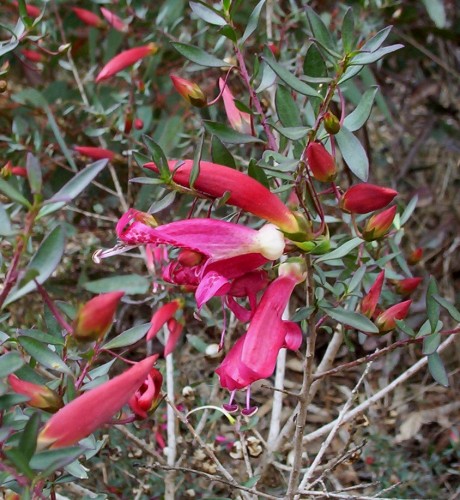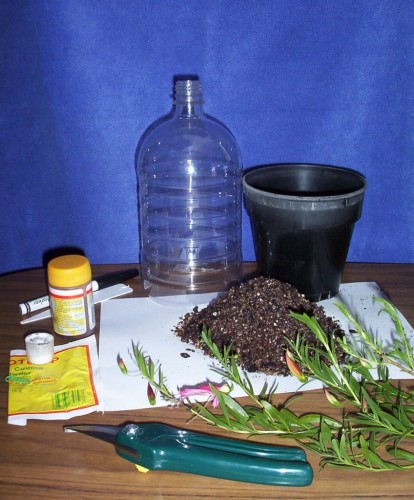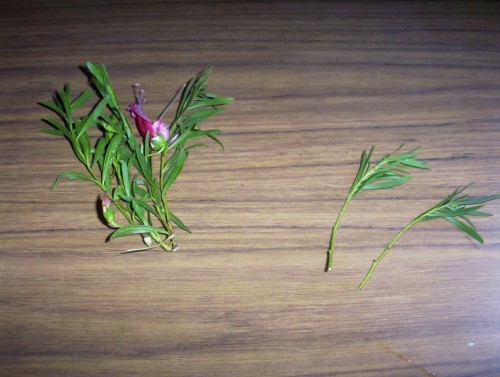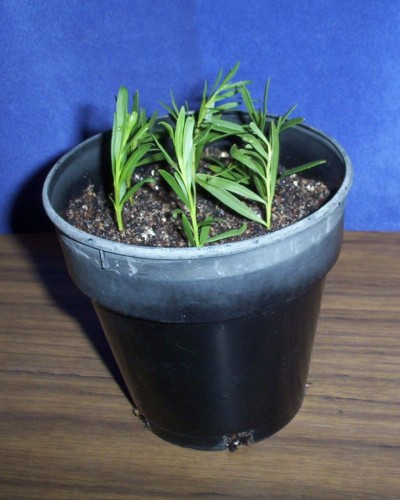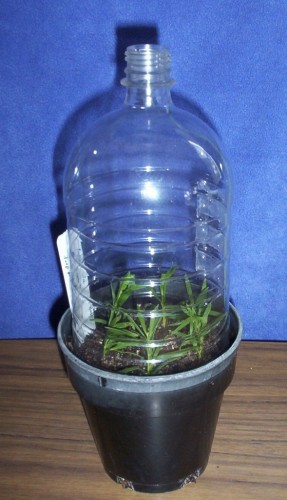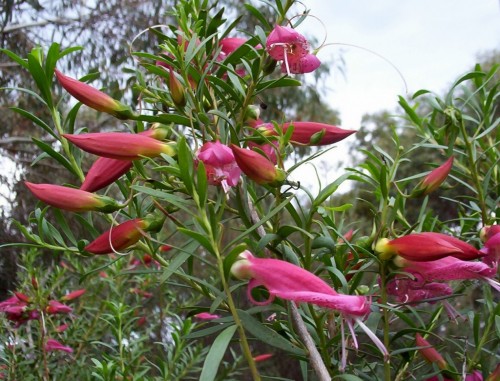Eremophila maculata compact form (Emu Bush)
This compact form of Eremophila maculata is a delight. It only grows about 60cm tall by about the same wide. The flowers are out of proportion to the size of the plant, being the same size as those on Eremophila maculata (Spotted Emu Bush).
All the desirable qualities apply to this plant. It is small, frost and drought hardy and lime tolerant. I think this plant flowers for a much longer period than the standard Eremophila maculata. Everyone admires the brilliantly coloured flowers. Like all Eremophilas, it benefits from light pruning or trimming from a young age.
The Mallee Ringnecks adore it and they can’t be wrong. It was an amusing sight, which we caught with the camera, to see one of the locals fly to the vicinity of the bush, waddle up to it and proceed to pick the flowers, get the nectar from the base of the tube and drop the flower to the ground before proceding to the next flower. The ground surrounding the bush was littered with chewed flowers. Destructive little beast! Incredibly this bush produces so many flowers that the chewed ones were not missed.
Potting Mixes For Propagating Plants
One of the most frustrating things about propagating plants and growing plants in pots is finding the right ingredients for potting mixes.
In the previous post Make New Plants… By Taking Cuttings, I mentioned obtaining a propagating mix. I have had to compromise with what is available locally. The basic idea of a propagating mix suitable for cuttings is to have excellent drainage, one that does not compact with watering, and maintains some moisture.
Traditionally, coarse sand mixed with peat moss was used. The difficulty is where does one get coarse sand? One of the potting mix companies now markets bags of coarse propagating sand. Whether you can buy it locally is another matter. Other ingredients readily available are blocks of coco peat (more environmentally friendly than peatmoss), vermiculite and perlite both of which are used in hydroponics. My compromise is a mixture of a reasonable bark based potting mix, coco peat and either perlite or vermiculite, in about equal proportions and moistened.
The main thing to do is to work on a recipe and if it works continue to use it. The most important consideration is to use clean ingredients.
Equally as important is to always mix the ingredients in the open and take care when opening bags of potting mix. Perlite floats. It can be a pest to use. A mask is a good idea as some people have been known to contract Legionnaires disease from dry potting mix floating in the air. Keep potting mix moist rather than allowing it to become powder dry.
No.2 of a series on Propagation
Make New Plants… By Taking Cuttings
I received an email from a friend who offered her garden to me to come and get some cuttings. With its mixture of exotics and Australian native plants this is the equivalent of offering me a block of chocolate 😀 .
Why take cuttings? Plants like Eremophilas (Emu Bushes) are difficult to raise from seed. If a particular flower colour or plant habit is required, taking cuttings from the plant with these desirable qualities guarantees that the new plant will have the characteristics that are wanted.
This is a great time of the year in South Australia to begin setting cuttings as the warmth stimulates root growth quickly because many plants are in growth mode.
This is basically how I do it.
- Collect together a suitable clean pot (140-150mm across) with good drainage holes, some freely draining propagating mix, sharp secateurs or snips, some sort of plant hormone powder or gel (from garden centres) if needed, a label and suitable pen, a plastic bag or plastic drink bottle with the bottom removed.
- Fill the pot with the mix within 2-3 cm of the top and firm down gently.
- Collect the cutting material. (I used Eremophila maculata from the bush in the previous post.) Trim it to length (about 10cm long) making a cut immediately below a point where a leaf joins the stem. This point is called a leaf node. Remove the lower leaves on the stem, cut any large leaves in half. Always keep moist by standing in water or keeping it covered with plastic or moist paper.
- Dip the end of the cutting in the plant rooting hormone if using it. (Follow directions on the container.) Roots will grow from this point and sometimes along the lower part of the stem.
- Make a hole 2-3cm deep in the mix with a piece of dowel or knitting needle equivalent and insert the cutting. Firm the mix around the stem.
- Several cuttings can be placed in the one pot, suitably spaced so that the leaves do not touch one another.
- Water gently to settle the mix around the stems.
- Place the drink bottle over the top of the cuttings or the pot depending on size, write the name of the plant on the label, where the piece came from and the date and put the lot in a warm spot out of direct sunlight.
- The mix needs to be kept moist not soggy, so watering may be necessary only once a week depending on the ingredients in the propagating mix.
- The cover retains humidity around the leaves of the plant pieces. Small heated propagators can be purchased which make the rooting process occur quicker. A hot house, which I use, is ideal. In this case the extra cover over the cuttings is unnecessary. The idea is to keep the leaves cooler than the mix in the pot. Slight moisture on the leaves achieves this cooling effect much like perspiration does in humans.
- Roots should appear in 3-6 weeks depending on the weather and the type of plant.
Some Australian native plants are notoriously difficult to strike but I never give up entirely. One never knows when success will come.
- This article has been submitted to the writing project “How to…” organised by Darren Rowse at ProBlogger
- More details on the above points in the next couple of posts.
Eremophila maculata (Spotted Emu Bush)
This is another very hardy plant. Eremophila maculata (Spotted Emu Bush) occurs in a number of colours and habits, from a shrub to two and half metres by about the same wide, to a sprawling plant about half a metre tall by about 2 metres across.
The plant in the photo is a dark pink form to 2 metres high and across here. It has large tubular flowers with spots inside the throat of the tube. The Honeyeaters absolutely love this shrub. They have been very busy nesting and arguing over territory and there seems to be a lot of different species around this year. The eremophilas are providing a wonderful food source at the moment.
This eremophila is one that grows best in heavier soil that is well drained. It is a very hardy plant. They don’t mind dappled shade for part of the day or the root competition from the nearby mallee trees. Soil with a very high pH like we have here is no bother either.
Eremophila maculata makes a great screening or hedge plant. It responds to very hard pruning by sending out many sprouts from the cut site.
Thomasia petalocalyx (Paper Flower)
One of my ambitions has been to get a photographic record of the Australian native plants which occur in the South Australian Mallee. In particular I want a record of flowering plants in the local mallee. We went for a drive the other day and found a few I haven’t seen flower for years. This could be due to the fact that we haven’t been in the area at this time of the year for ages.
Thomasia petalocalyx (Paper Flower) is one of the pretty local natives that grows well in the garden. This photo was taken in mallee scrub south of here. The plant grows to about a metre tall and is wider. The nodding flowers are a pretty mauve and have a papery quality about them. The bush seems to have flowers on it most of the year.
Once again this is a hardy, drought tolerant plant. The leaves are a little hairy which possibly means that it needs to be in an open position in areas where high humidity occurs. This plant also occurs in Western Australia and Victoria.
